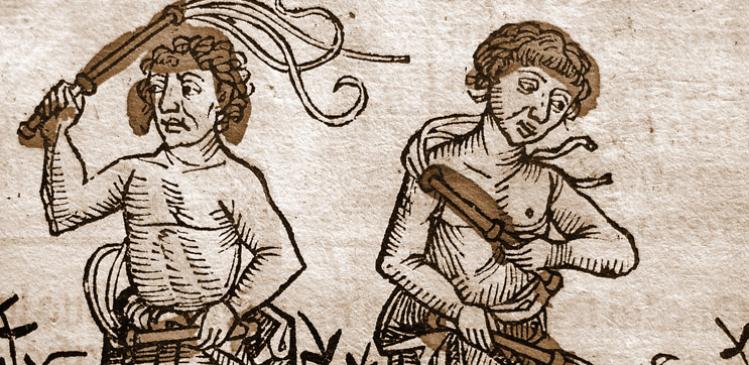
Easygoing by temperament, and without any desire for dramatic feats of spiritual heroism, I have always been drawn to the more relaxed spiritual disciplines the church has to offer—things like contemplative prayer, the Daily Office, and Lectio Divina. All involve sitting in comfortable positions and closing your eyes. No one gets too excited if you happen to doze off. When I decided to enter a religious order as an oblate, I chose the Benedictines, attracted to their balance of prayer and work, (“ora et labora”). The Rule of Benedict, famously sane, is, with a few adjustments, as applicable to a married-with-children lawyer like myself as to a cloistered monk.
Not surprisingly, I tend to be skeptical of tales of extraordinary self-mortification. Stories of hair shirts, self-flagellation, and crawling up and down cathedral steps on one’s knees strike me as neurotic rather than as authentic expressions of Christian faith. Certainly, such practices had never inspired me as models for my own spiritual life. Who needs a hair shirt when your seven-year-old is throwing up fish’n’chips into your hands at Red Robin?
But I have recently begun to wonder if a more austere approach is not sometimes necessary. In the normal rough-and-tumble of Catholic life, I have seen many of my sins and harmful habits wither away, with new virtues taking root. But the tenacity of a few particular sins is remarkable. These persistent sins have three characteristics: (1) they speak to the very heart of my character; (2) I know they are harming me; and (3) I really enjoy them.
When I manage to say no to these sins for any period of time, I fear I am on the verge of losing them forever and I scramble to experience them again. In those moments, I understand Gollum’s pain in The Hobbit when he realizes he has lost his ring to Bilbo: “Curse us and crush us, my precious is lost!”
Which brings me back to the hair shirts. Perhaps self-inflicted irritants do have a place in authentic Catholic spirituality. I say this with extreme caution, but if saying no to sin is going to cause pain anyway, then maybe I should learn to endure pain, if for no other reason than to accept it as a part of growing in virtue. Like a boxer learning to take a punch, perhaps we can become spiritually tougher by means of small self-mortifications.
The Catechism of the Catholic Church captures this dichotomy of pain in spiritual life. On the one hand, the “way of perfection passes by way of the Cross. There is no holiness without renunciation and spiritual battle. Spiritual progress entails the ascesis and mortification that gradually lead to living in the peace and joy of the Beatitudes” (2015). On the other hand, Jesus’ call to conversion and penance “does not aim first at outward works, ‘sackcloth and ashes,’ fasting and mortification, but at the conversion of the heart, interior conversion. Without this, such penances remain sterile and false; however, interior conversion urges expression in visible signs, gestures, and works of penance” (1430).
Slowly, and with some trepidation, I am beginning to warm up to the age-old wisdom that detachment from disordered loves is essential to the spiritual life. Still, I find myself mortified at the idea of mortification, particularly my own. I find that St. Augustine’s famous prayer, “Give me chastity and continence, but not yet” resonates deep inside me.
What helps me approach the Lenten disciplines of prayer, fasting, and almsgiving is that they are, among other things, measured pains. They are concrete ways of saying no to sin. Ash Wednesday begins with the most difficult of the three, at least for me: fasting. The Ash Wednesday Collect states, “Grant, O Lord, that we may begin with holy fasting this campaign of Christian service, so that, as we take up battle against spiritual evils, we may be armed with weapons of self-restraint.”
At first blush, the battle with my grumbling stomach hardly resembles a battle against spiritual evil. But my voluntary detachment from food, experienced as hunger, is a powerful metaphor for my hunger for sin. The pain of saying no to food builds the spiritual muscle to resist temptation. The small pain of fasting directs my prayers toward asking what really gives me life and sustains me. It also helps me realize that the physical and spiritual needs of others are similar to my own. It’s no wonder that the church, following Jesus, links fasting, prayer, and almsgiving.
Ultimately, however, the focus of self-mortification is not on pain, but on joy and freedom—freedom from the addictively pleasurable bonds of sin and self. Like any addiction, sin closes us off from the one who made us, and strips us of our ability to love. Knowing this makes self-mortification seem less like a kind of spiritual athletics and more like a method of surrender.
Please email comments to [email protected] and join the conversation on our Facebook page.
Share
Previous Story
The Bibi-Boehner Coalition
Next Story
Poem | Celeriac